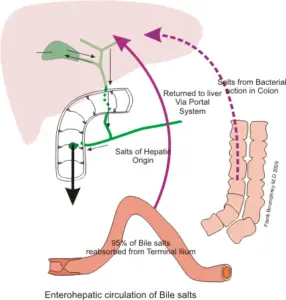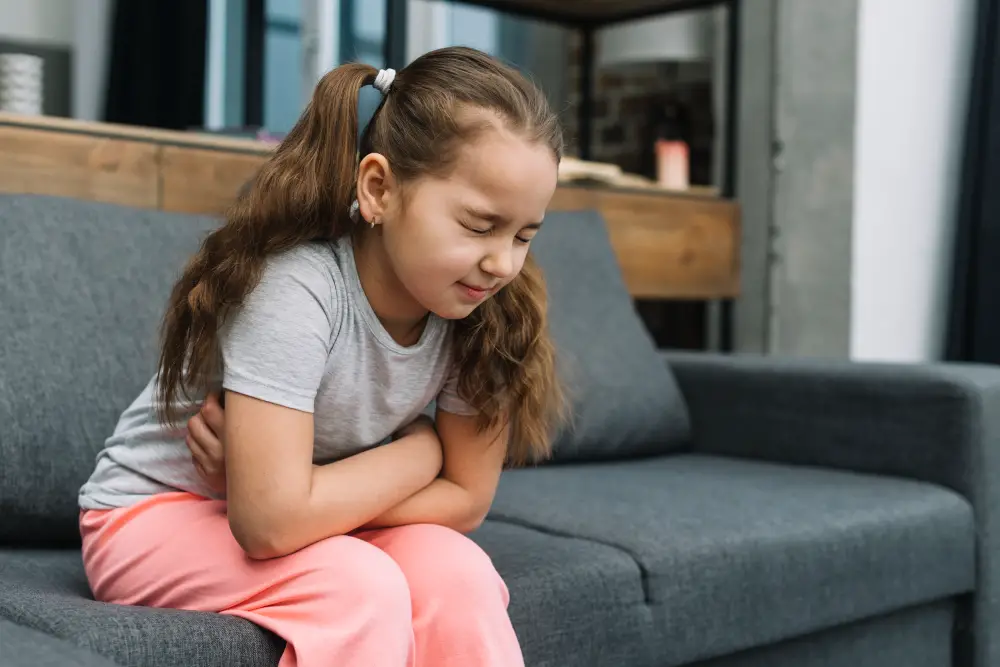
Gallbladder symptoms in children will be discussed in the following article. The gallbladder does not belong to the group of necessary organs (unlike the kidneys, liver, and heart), but this organ has an important role in the digestive processes. The bile produced in the liver is stored and concentrated in the gallbladder. After having a meal, the gallbladder will release some bile into your intestines, to break down the fats and facilitate the digestion of foods.

Bile is greenish or brownish fluid, composed of water, some inorganic salts, pigments, and cholesterol. The gallbladder can store nearly fifty milliliters of bile (we are talking about the gallbladder of an adult person). A certain amount of bile stays inside the gallbladder, and during this time, it is getting more concentrated – and more potent – which will facilitate digestion.
Gallbladder problems are usually caused by gallstones. The stones are composed of cholesterol, pigments, and salts, but they vary in composition, size, shape, and color. Some stones are very small – almost invisible. These stones never cause any problems, and they are asymptomatic, so people can live with these stones for decades. Larger stones cause complications, and most gallbladder disorders are triggered by such stones. Let us learn more about the risk factors in adults, and then we will compare them to those in children.
- Hashimoto’s Disease
- Food allergies or sensitivities
- Quick weight loss
- Obesity
- Low stomach acid
- Heartburn
- Alcohol intake
- Hypothyroidism
- Fe males are especially prone to gallbladder problems
- Cholesterol-lowering medications
- Non-fat diets
- Diabetes
- Estrogen intake
- Antacids
- Birth control pills
- The risk increases with age; people who are over 40 are particularly prone to gallstones
- Antidepressants
- Heredity
- Constipation
- Foods rich in saturated fats
- Ethnicity
- Decreased HDL cholesterol
Those are some of the common risk factors in adults. Let us find out more about the risk factors in children.
Gallbladder Problems in Children: The Most Common Causes
- Weak immune system
- Some medications
- Biliary tract problems
- Abdominal surgery
- Trauma
- Acute renal failure
- Malnutrition
- Parenteral nutrition
- Weight loss diet
- Hemolytic disease
- Chronic liver disease
- Obesity
Gallbladder disorders can occur in children, and these problems can be chronic or acute.
– Chronic cholecystitis usually lasts long, unlike acute cholecystitis (which is more common).
– Acute cholecystitis is caused by infections (either bacterial or viral).
Children can suffer from gallstones, just like adults. The stones that affect children are usually high in bilirubin, and they are darker in color.
Gallbladder Symptoms in Children
- The symptoms of gallbladder disease in children are not much different from those in adults. However, gallbladder disease can be difficult to recognize in children, because the symptoms are non-specific, and a child cannot always define what he/she is feeling.
- Abdominal discomfort and abdominal pain are the common symptoms in children. The pain is located on the right side, and it starts after eating. It can start at night and last for several hours.
- Nausea, vomiting, and indigestion can occur along with abdominal discomfort.
- Belching, bloating, burping and gas can start after a meal
If your child has a fever, this can be a sign of a serious gallbladder problem.
If your child starts complaining about any of these problems, take him/her to the doctor. Gallbladder symptoms are similar to those of other diseases, so you must ask for a professional opinion! You must never ignore such symptoms, even if your child appears perfectly healthy.

Gallbladder Treatment for Children
The treatment options for gallstones in children are generally similar to those in adults, but the approach may vary depending on the severity of the condition and the child’s overall health. Here are some of the available treatments for gallstones in children:
- Observation: In some cases, especially if the gallstones are small and asymptomatic, doctors may choose to monitor the child’s condition without immediate intervention. This approach is often taken if the child is not experiencing any symptoms and the gallstones are not causing complications.
- Dietary Changes: Making dietary modifications may help manage symptoms and prevent the formation of new gallstones. This may involve reducing the intake of fatty or greasy foods, which can trigger gallbladder symptoms.
- Medications: Ursodeoxycholic acid (UDCA) may be prescribed to dissolve cholesterol gallstones over time. This medication works by reducing the cholesterol content in bile, thereby preventing the formation of new stones and aiding in the dissolution of existing ones.
- Extracorporeal Shock Wave Lithotripsy (ESWL): In some cases, ESWL may be used to break up gallstones into smaller fragments that can pass more easily through the bile ducts. This non-invasive procedure uses shock waves to fragment the stones, allowing them to be eliminated naturally.
- Surgical Removal of the Gallbladder (Cholecystectomy): If the child experiences recurrent or severe symptoms, or if complications such as inflammation of the gallbladder (cholecystitis) or obstruction of the bile ducts occur, surgical removal of the gallbladder may be necessary. This procedure, known as cholecystectomy, is typically performed laparoscopically and is considered safe and effective.
- Endoscopic Retrograde Cholangiopancreatography (ERCP): In cases where gallstones have migrated into the bile ducts, causing blockages and complications such as pancreatitis, ERCP may be performed. During this procedure, a flexible tube with a camera (endoscope) is inserted through the mouth and into the digestive tract to remove the stones or relieve the blockage.
The choice of treatment depends on various factors, including the child’s age, overall health, the size and number of gallstones, and the presence of symptoms or complications. It’s important for parents to work closely with healthcare providers to determine the most appropriate course of action for their child’s condition.


Leave a Reply